Types of salvias: 16 best varieties for beds, pots and borders
Try these 16 stunning types of salvias to bring endless color, fragrance and sensory delights to every size of garden

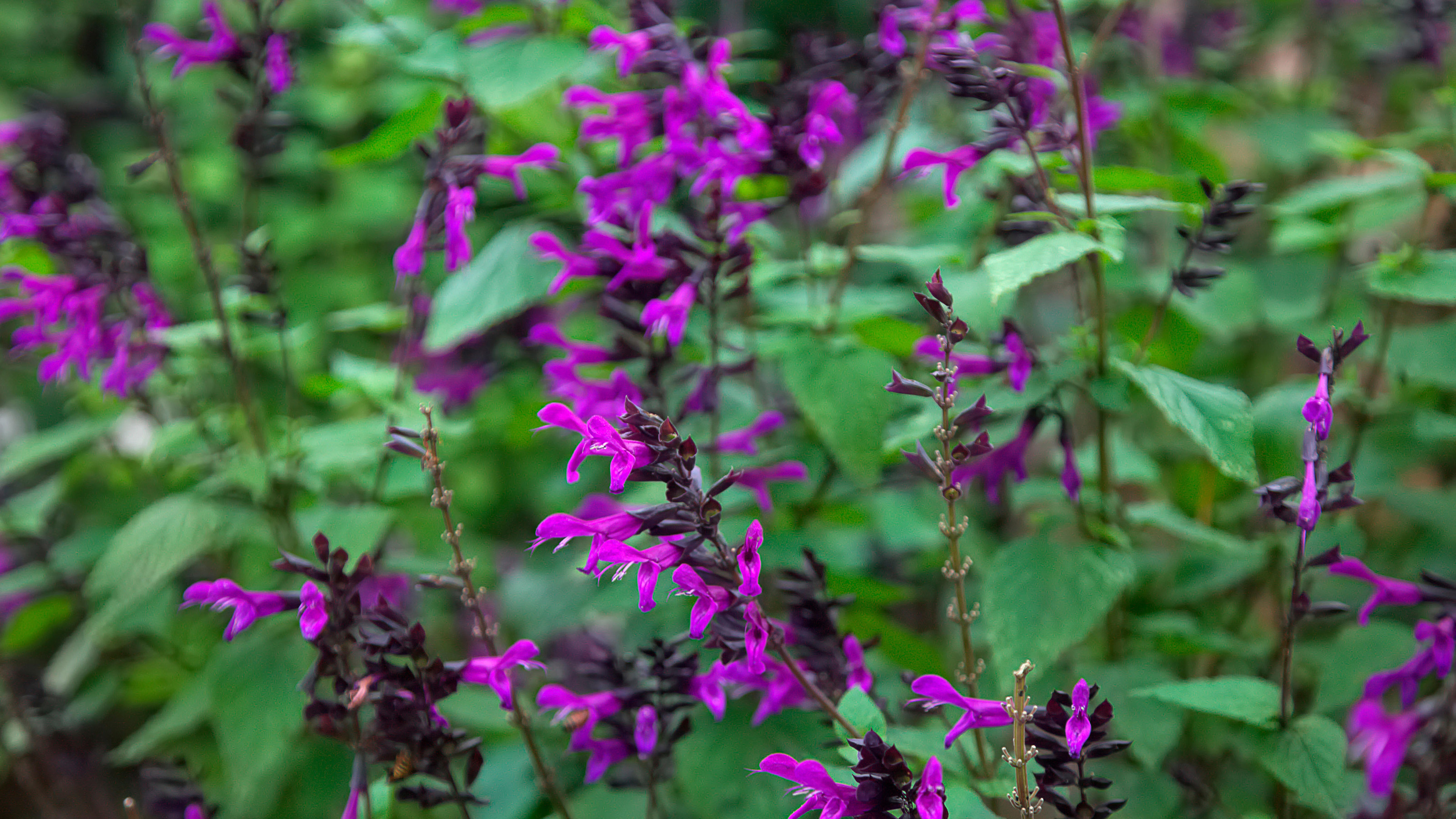
There are so many types of salvias, you could spend years discovering new varieties – you may wish to move to a place with a bigger garden to fit them all in! Along with an endless variety of hue and fragrance, these summer stalwarts have great drought tolerance and also perform well in milder climes. They are long-flowering, low-maintenance and offer great wildlife value. If this were not enough, they are resistant to many of the usual pests that munch through our summer plants.
Traditionally, spikes of scarlet showcased summer bedding salvias, available via S. splendens and its cultivars. In the 1990s, breeding intensified. Now, many salvia varieties have salmon-pink, lilac, lavender, purple, white and burgundy blooms. There are even bi-colored forms, with bracts of differing shades. You can also grow green, purple and variegated foliage; these aromatic and tactile sages have soft, felted leaves, ideal for sensory gardens.
Salvias can be grown as perennials or annuals, depending on region and risk of frost. There is one true annual, S. viridis (formerly S. horminum). Once used as a culinary herb, it is now grown mainly for its colored bracts, and the introduction of the Marble Arch Series has given us deep blue, white and rose options. Permanent salvia plantings are increasingly popular, with hardiness becoming less of a problem.
These versatile plants and shrubs work beautifully in a range of locations, including cottage gardens and pollinator-friendly flower beds, exotic borders, herbaceous plots, inventive containers and modern patio schemes. Whatever your gardening aspirations may be, there’s a salvia that’s sure to fit the bill. Here, we round up some of the most inspirational selections to help you find your favorites.
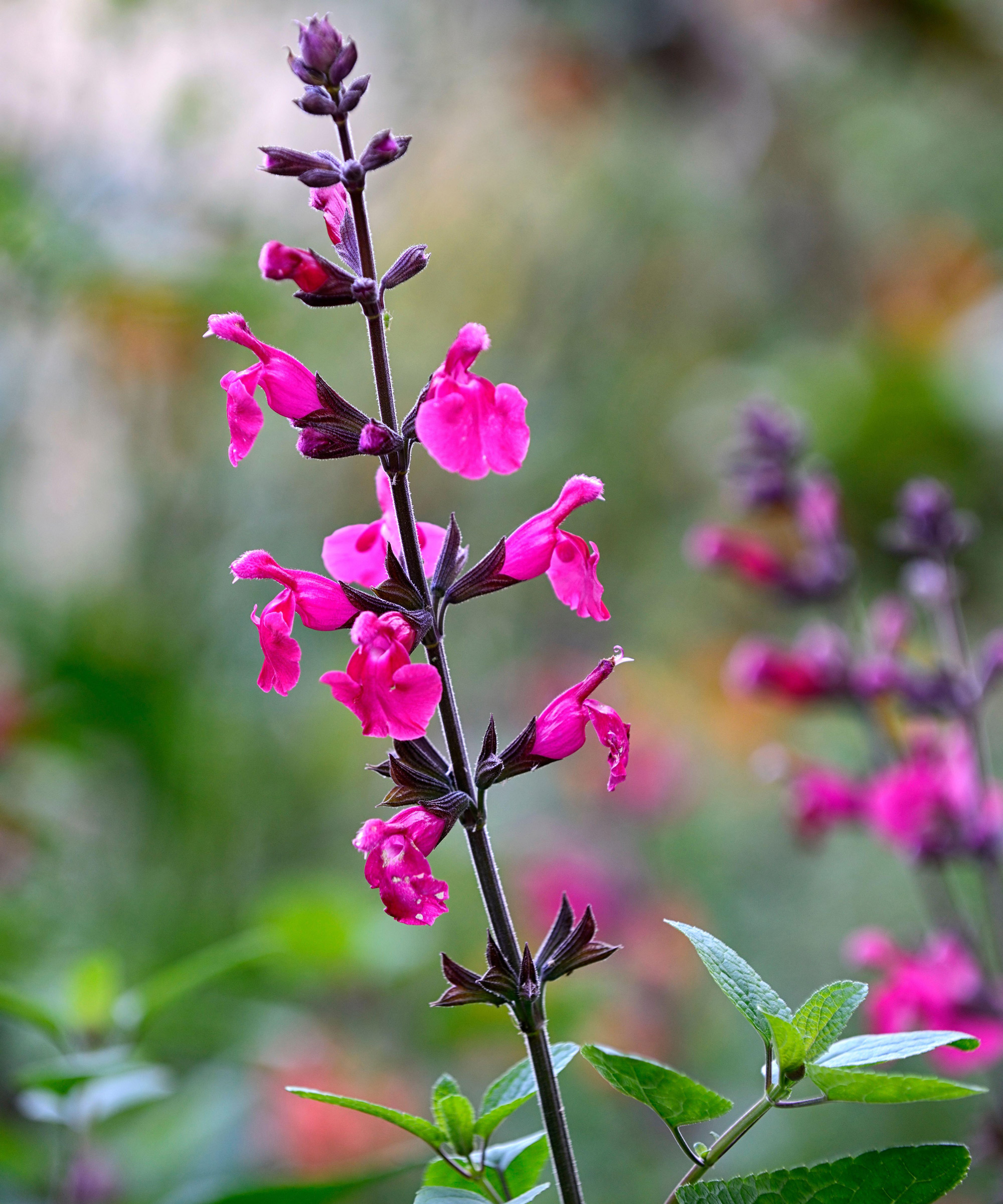
16 types of salvias to try for scent and style
Ornamental and edible sages come in a staggering range of vibrant and fragrant plant forms. They present in a dazzling array of colors, from whites and soft pastels to intense violets, blues and burgundy blacks. Many breeds offer dual tones and mixed foliage options too. Happy in full sun and free-draining soil, these 16 types of salvias are ideal in flower beds, patio containers and garden borders, so find out which is best for you.
1. Salvia ‘Joan’
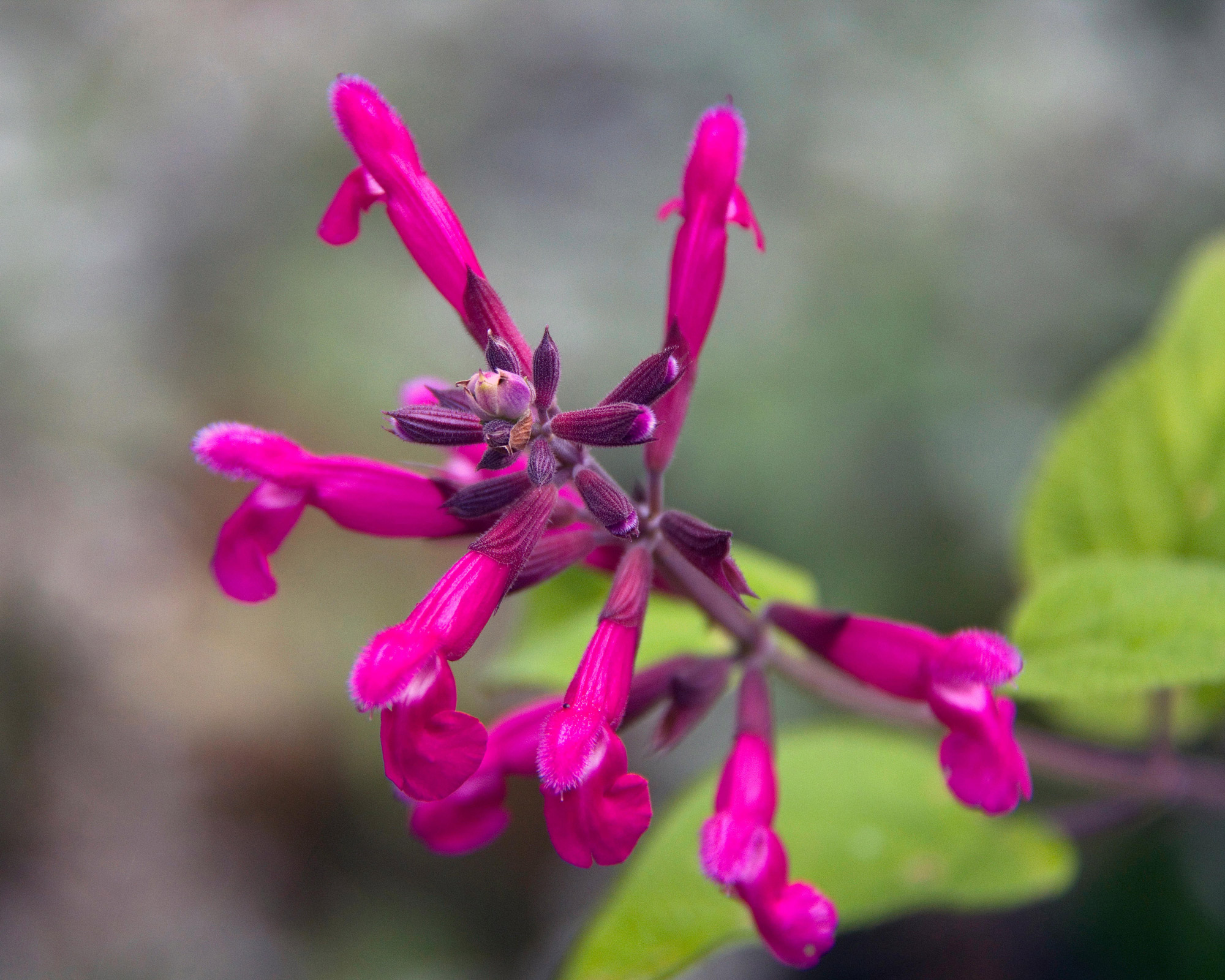
- Height: 4-5ft (1.2-1.5m)
- Best for: sunny borders
A bushy perennial salvia, ‘Joan’ is a vibrant hardy hybrid. For those in search of the best patio plants, ‘Joan’ is a very pretty choice for a large patio container as well as for spots in a sunny border.
These types of salvias produce many branches of pale green leaves. Masses of furry buds turn into showy, dusky magenta flowers. This salvia, which has overwintered in many gardens over recent years, has lots in common with S. ‘Bethelli’, S. ‘Boutin’ and S. ‘Mulberry Jam’.
2. Salvia ‘Amistad’ AGM
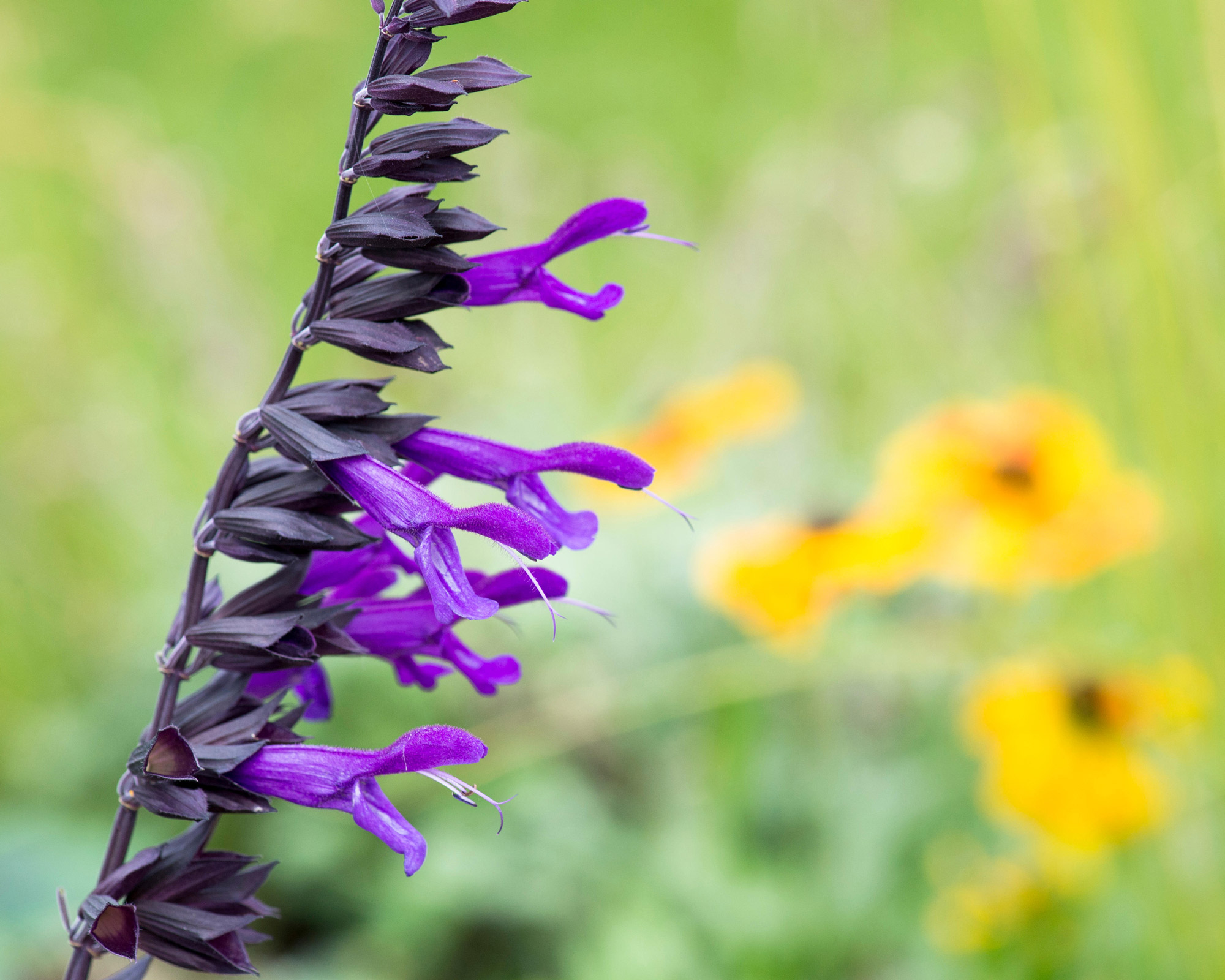
- Height: 4ft (1.2m)
- Best for: purple flowers
Floriferous ‘Amistad’ is one of the most unusual types of salvias you can try, with large, velvety petals. For those who love purple flowers, these salvias have deep purple blooms with blackish stems. Bees love it!
Keep deadheading this AGM-winning salvia, and it will flower from late spring to mid-fall.You can also keep it alive over winter if kept frost-free. ‘Amistad’ needs a well-drained sunny, sheltered site.
3. Salvia ‘Penny’s Smile’
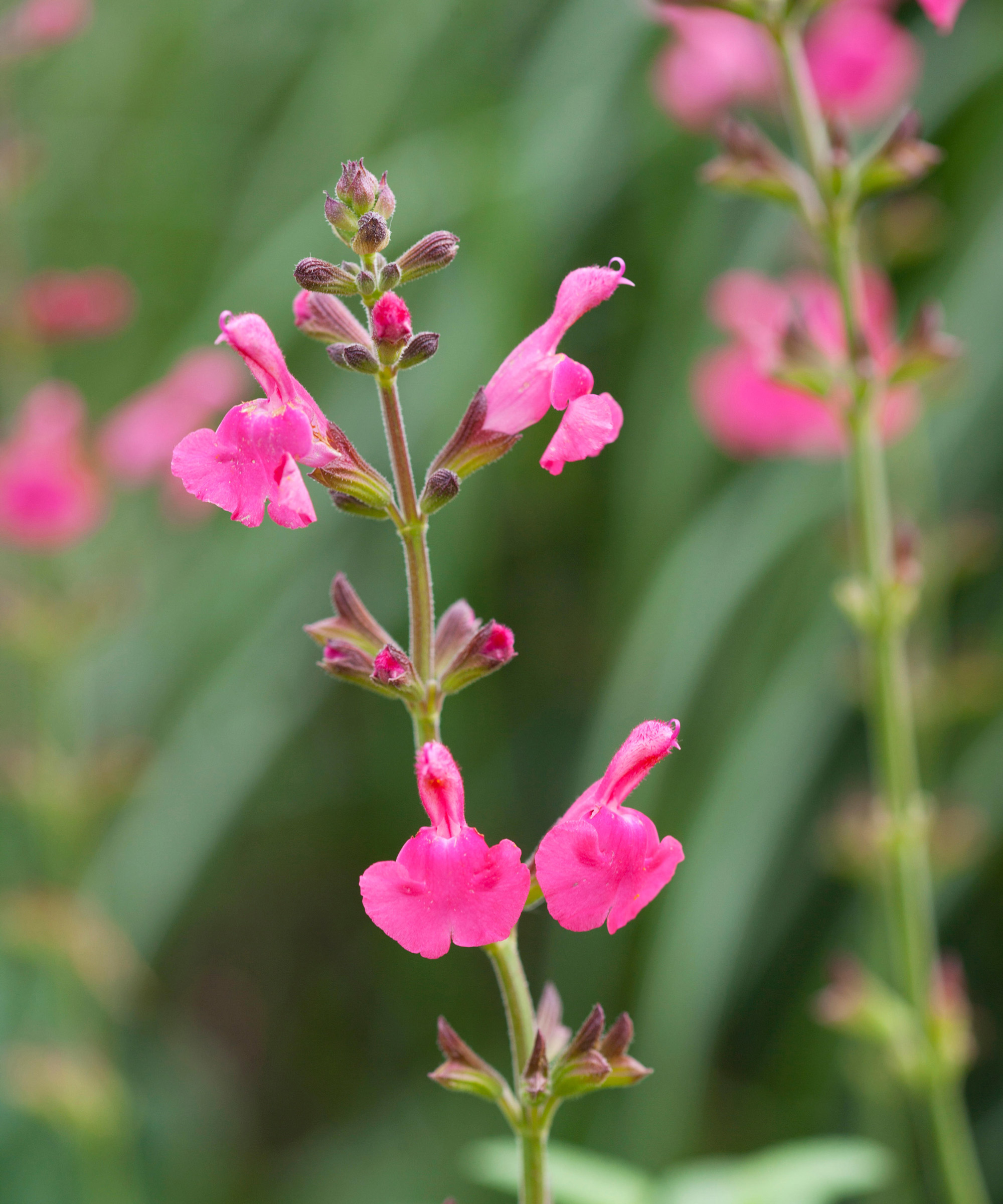
- Height: 4ft (1.2m)
- Best for: tall displays
Salvia ‘Penny’s Smile’ is an upright sub-shrub with mid-green leaves, which stay in place over mild winters. Lovely magenta-pink flowers are carried along the stems of these types of salvias, blooming late summer to fall.
This is one of the few salvia varieties which benefit from climbing plant support in summer, particularly if you have a windy garden. It’s also a good idea to take cuttings during autumn.
- Buy ‘Penny’s Smile’ in the UK: view at Annie’s Annuals
- Buy ‘Penny’s Smile’ in the UK: view at Ashwood Nurseries
4. Salvia ‘Hot Lips’ AGM
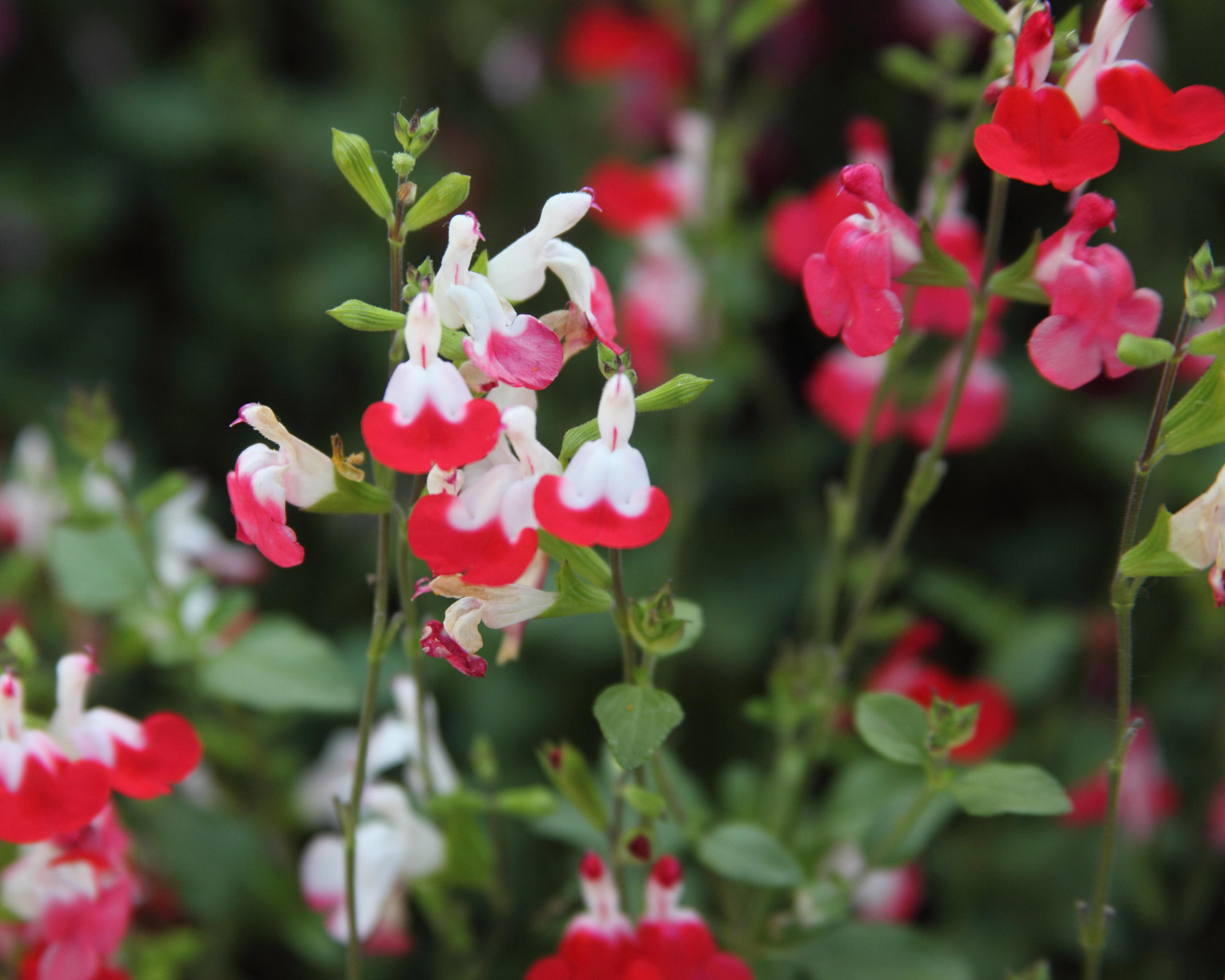
- Height: 39in (1m)
- Best for: mixed color
For those in search of something a little more unusual, Salvia ‘Hot Lips’ is one of the most-often seen cultivars – and for good reason. As well as being one of the hardiest types of salvias and utterly reliable, it works well in bold garden color schemes thanks to its unique floral hues.
This AGM-winning salvia has stunning cherry red and white flowers, borne along the stems from late summer to fall. Sometimes these blooms may appear all-red or all-white, but mostly they are bi-colored.
5. Salvia ‘Jemima’s Gem’ (Jemco)
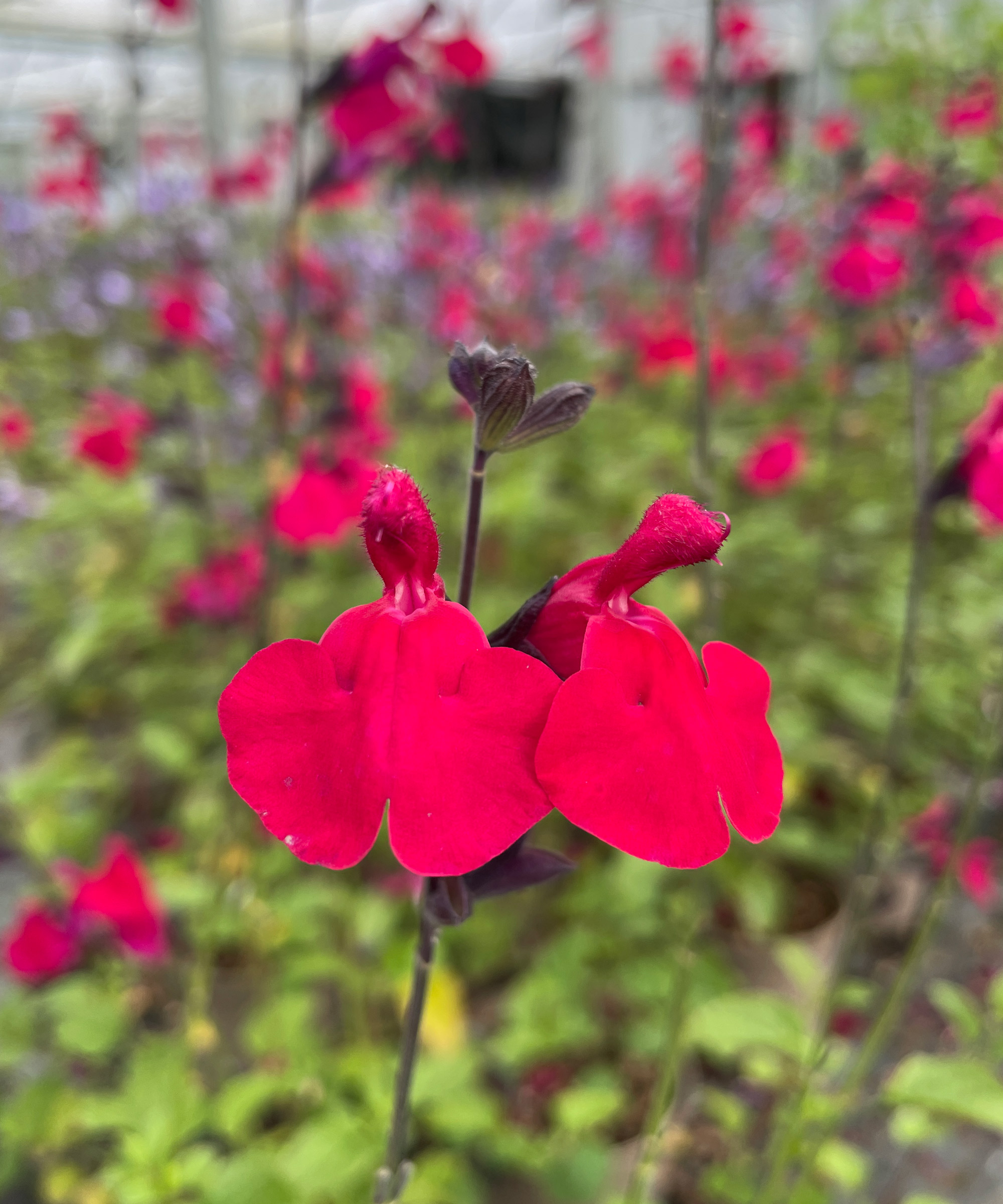
- Height: 39in (1m)
- Best for: colorful containers
Very vibrant as well as very hardy, this shrubby perennial has a bright pinkish red flower, which will really stand out in a garden. It only needs protection in cold or exposed gardens, or if a severe frost is forecast.
If you are looking for the best perennial plants for pots, these shrubby salvia varieties are ideal. Perfect for pots or borders, ‘Jemima’s Gem’ (aka Jemco) can provide color as early as mid spring and as late as early winter.
6. Salvia greggii ‘Icing Sugar’
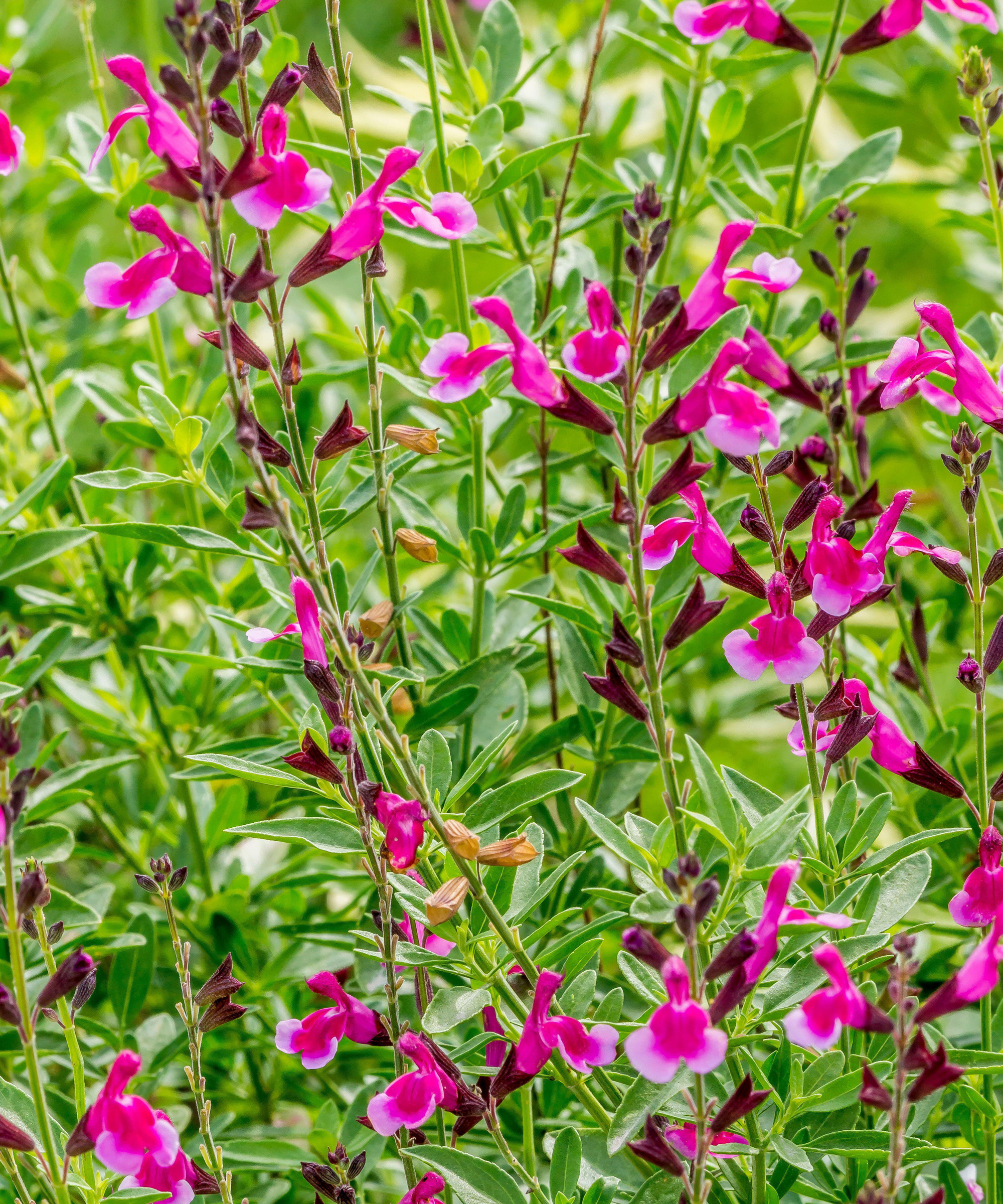
- Height: 28-39in (70-100cm)
- Best for: drought tolerance
Also known as autumn sage, Salvia greggii ‘Icing Sugar’ is one of the best free-flowering types of salvias, flowering from mid summer to late fall. For lovers of pink flowers, this salvia produces lovely two-tone blooms of dark and pale pink.
The leaves of these salvia varieties are small and narrow – as well as deeply aromatic. Once established, it has demonstrated some of the best drought tolerance of any salvia. It should survive less harsh winters, but you may need to protect plants from frost if you live in a region where there is the risk of severe frost.
7. Salvia × sylvestris ‘Blue Marvel’
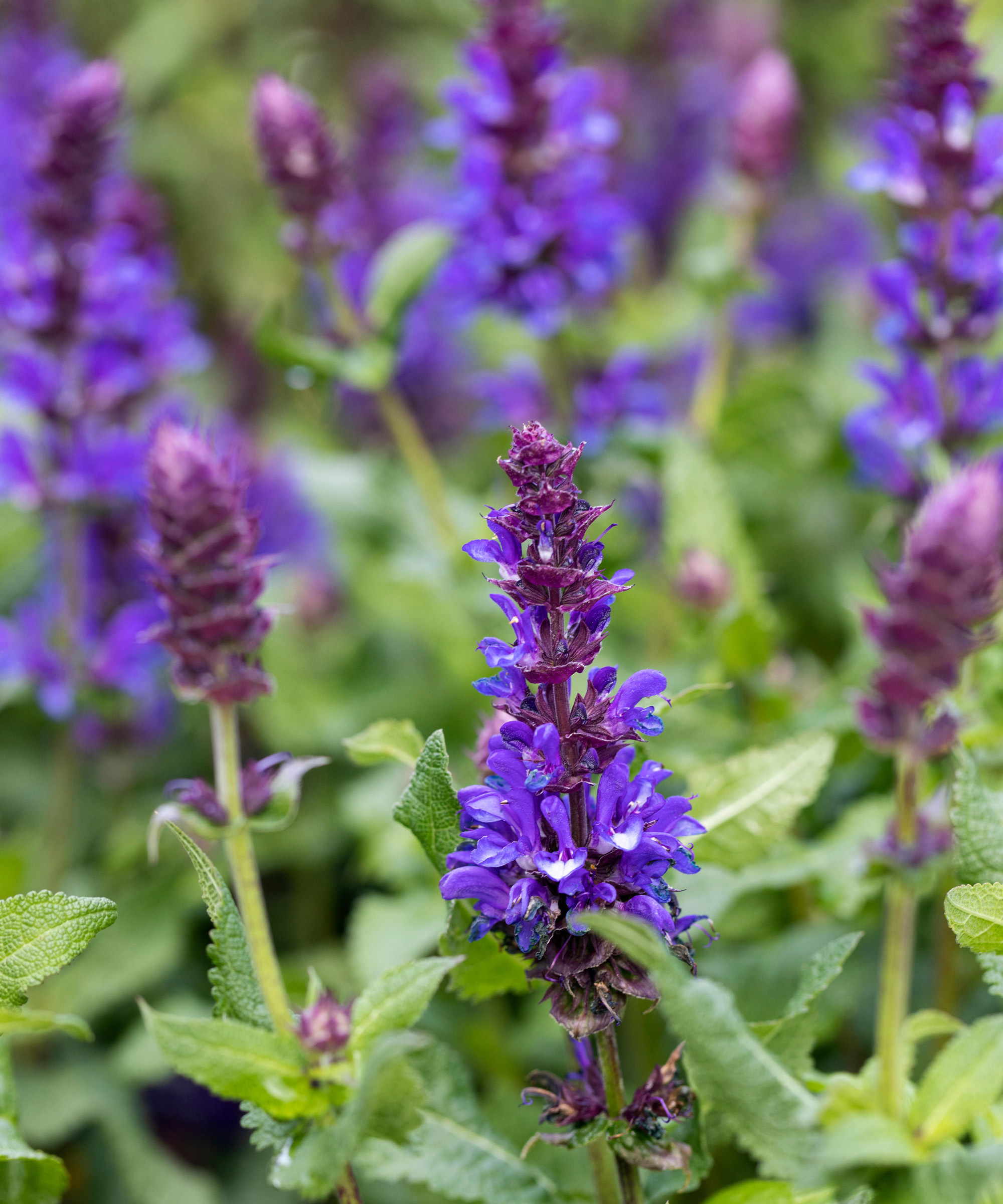
- Height: 24-36in (60-90cm)
- Best for: blue flowers
This fantastic, recently introduced salvia is perfect if you are looking for the best plants for small gardens and it is very hardy. Salvia × sylvestris ‘Blue Marvel’ (also known as wood sage) is great for sunny borders, edging pathways, filling beds, containers and even windowboxes.
The upright, deep purple-blue flower spikes of these types of salvias are noticeably larger than others within the species. They will keep coming, too, with consistent flower color all throughout the summer.
8. Salvia ‘Blue Note’
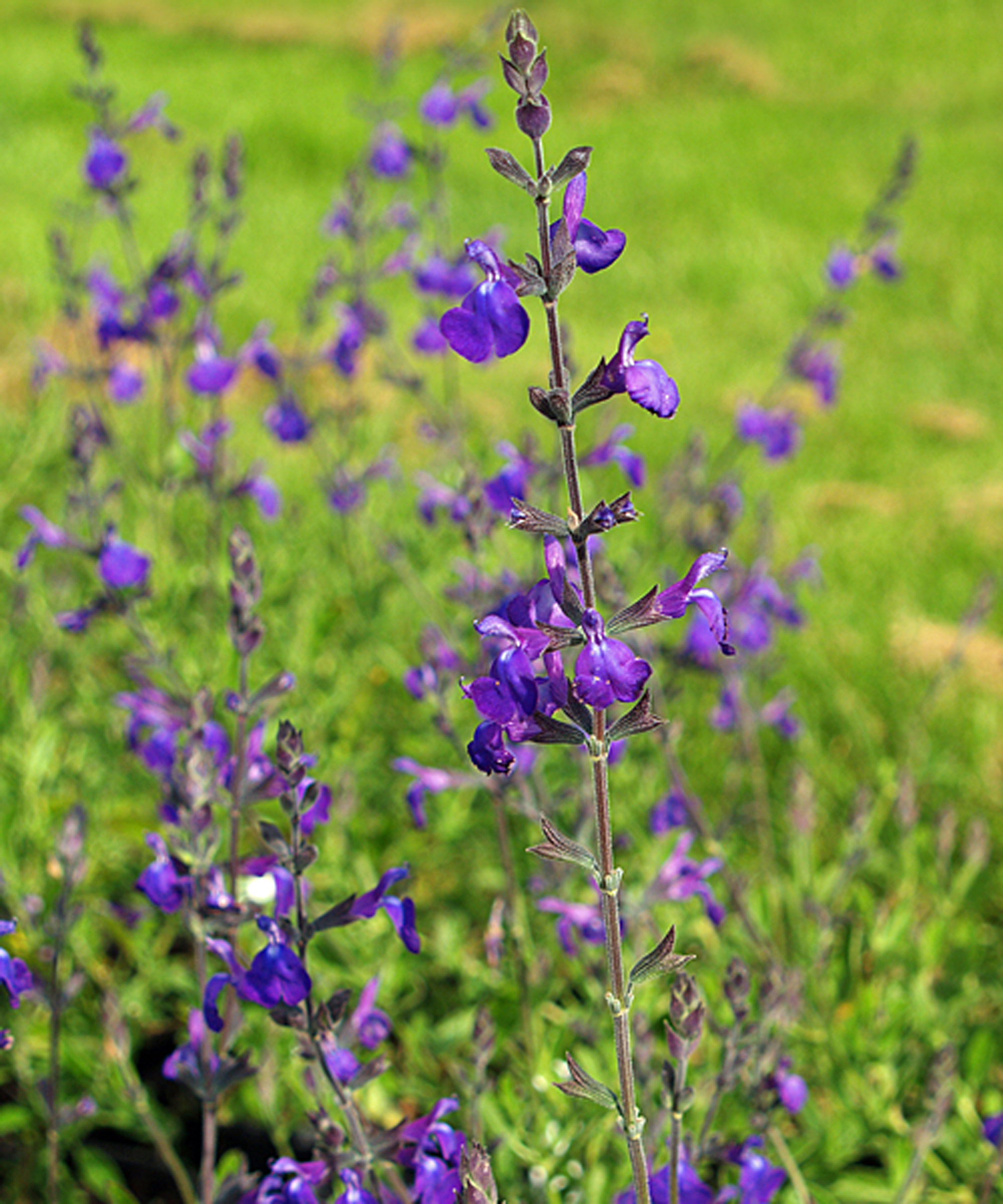
- Height: 20in (50cm)
- Best for: dainty plants
Not the largest or most dramatic of salvias, Salvia ‘Blue Note’ is here because it is delightfully dainty-looking. What it lacks in stature, it more than makes up for with its piercing royal blue flowers.
For those who enjoy landscaping with evergreens, there is good news with these types of salvias. If not cut back by frosts, this is a truly evergreen salvia. This small, shrubby variety has small, deep-green rounded leaves that are downy and aromatic.
9. Salvia ‘Dyson’s Joy’
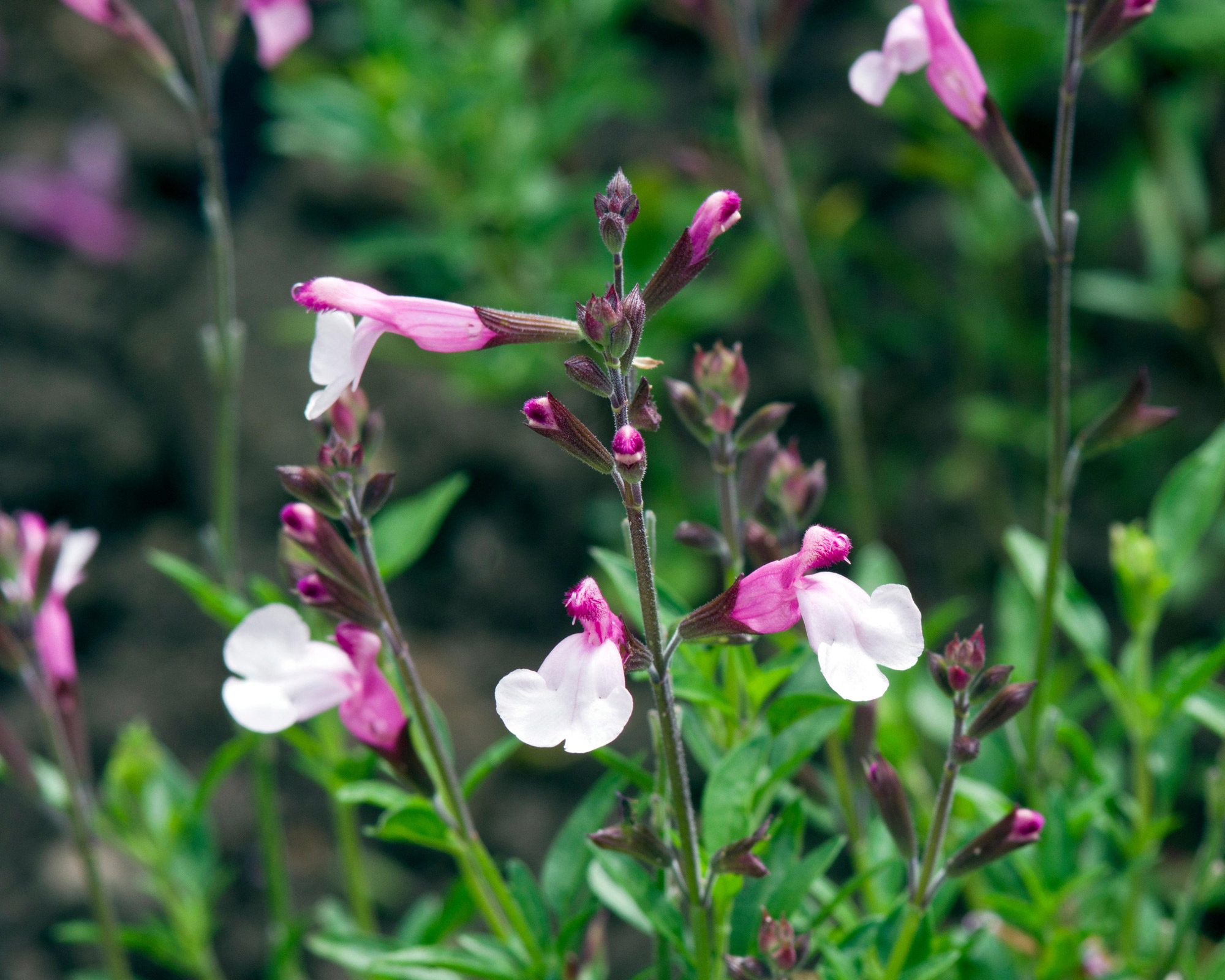
- Height: 20-24in (50-60cm)
- Best for: little perennials
Sometimes seen as just ‘Joy’, this salvia blooms from late spring to mid-fall. Salvia ‘Dyson’s Joy’ is an elegant little perennial and will be at its best in a sunny border. And for those after the best fragrant plants, these types of salvias are delightfully aromatic.
The flowers of this AGM-winning salvia present in two contrasting shades of pink, with maroon-purple bases. These blooms are carried in loose spikes above a neat clump of scented mid-green leaves.
10. Salvia leucantha AGM
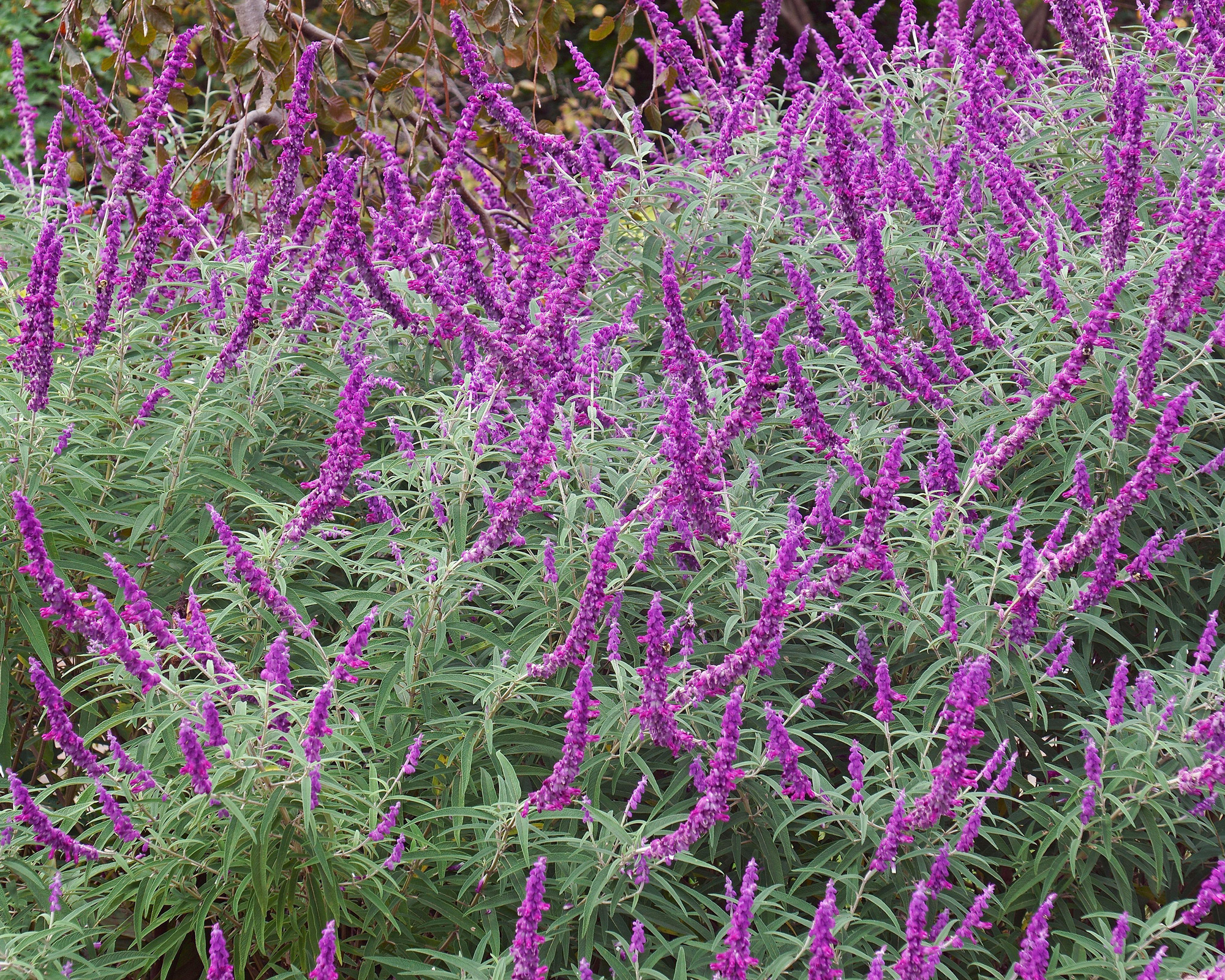
- Height: 4ft (1.2m)
- Best for: butterflies
This evergreen salvia is grown for its dense, arching, late summer and fall flower spikes. The blooms are bicolored, with purple calyces and white corollas. These white corollas fade first, leaving long-lasting purple spikes. Furthermore, the leaves of this AGM winner are soft and hairy.
If you are looking for the best plants for butterflies, then you’re in luck with Mexican bush sage. These types of salvias attract butterflies and bees, as well as other beneficial pollinators and wildlife.
- Buy Mexican bush sage in the US: view at Plant Delights
- Buy Mexican bush sage in the UK: view at Norfolk Herbs
11. Salvia ‘Vatican White’
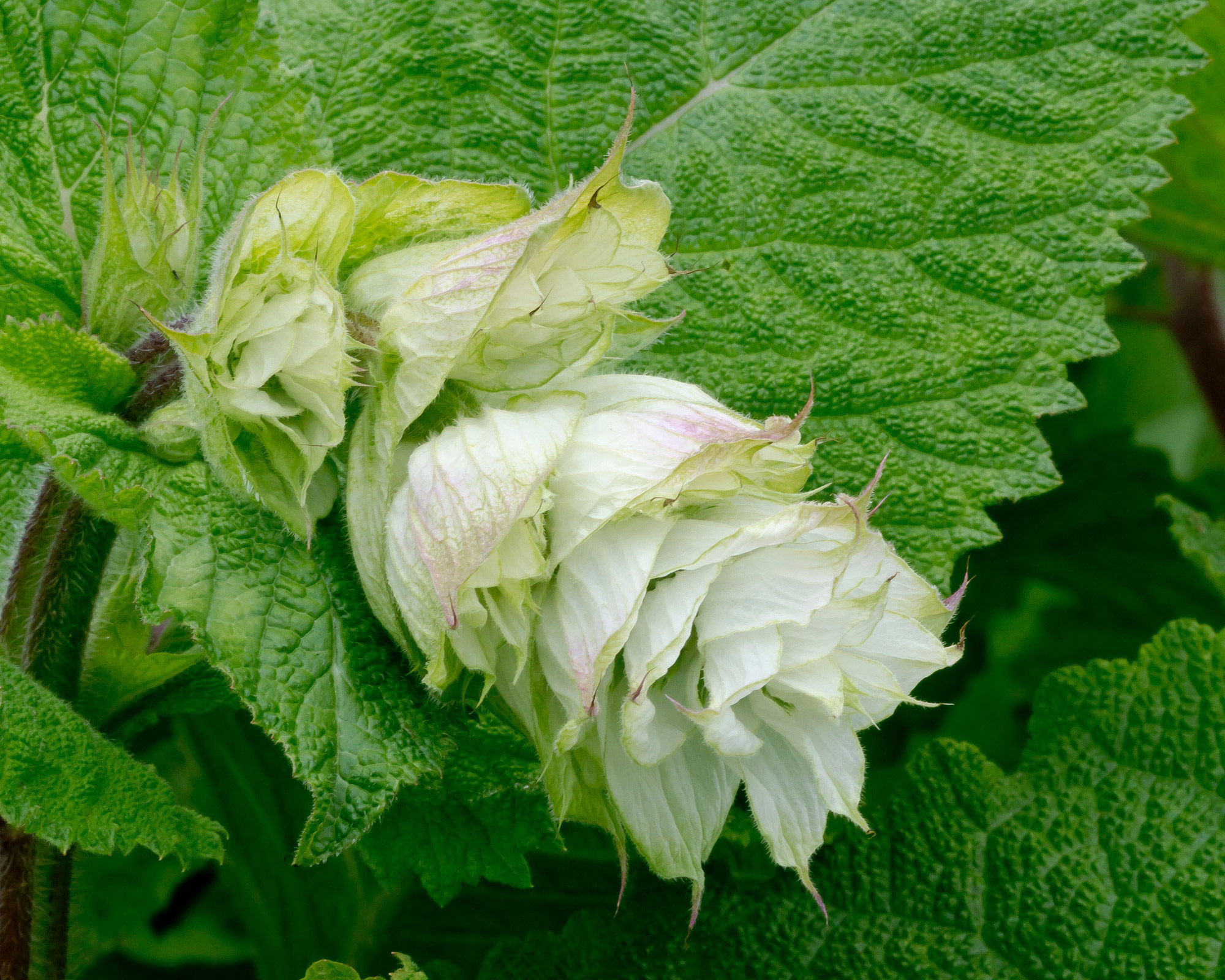
- Height: 28-39in (70-100cm)
- Best for: white flowers
As well as being another beautiful salvia for nectar production, ‘Vatican White’ is an elegant choice for bringing a flourish of purity to your plot. It will grow well in a poor, dry soil, but is bushier and lusher if grown in a fertile, moisture-holding soil.
The straight species of this salvia is valued for its crinkled leaves and upright bracts of pollinator-friendly purple flowers. But for lovers of white flowers, this stunning cultivar has large bright bracts embracing green buds which open into ivory blooms.
- Buy ‘Vatican White’ in the US: view at Select Seeds
- Buy ‘Vatican White’ in the UK: view at Chiltern Seeds
12. Salvia ‘Purple Rain’
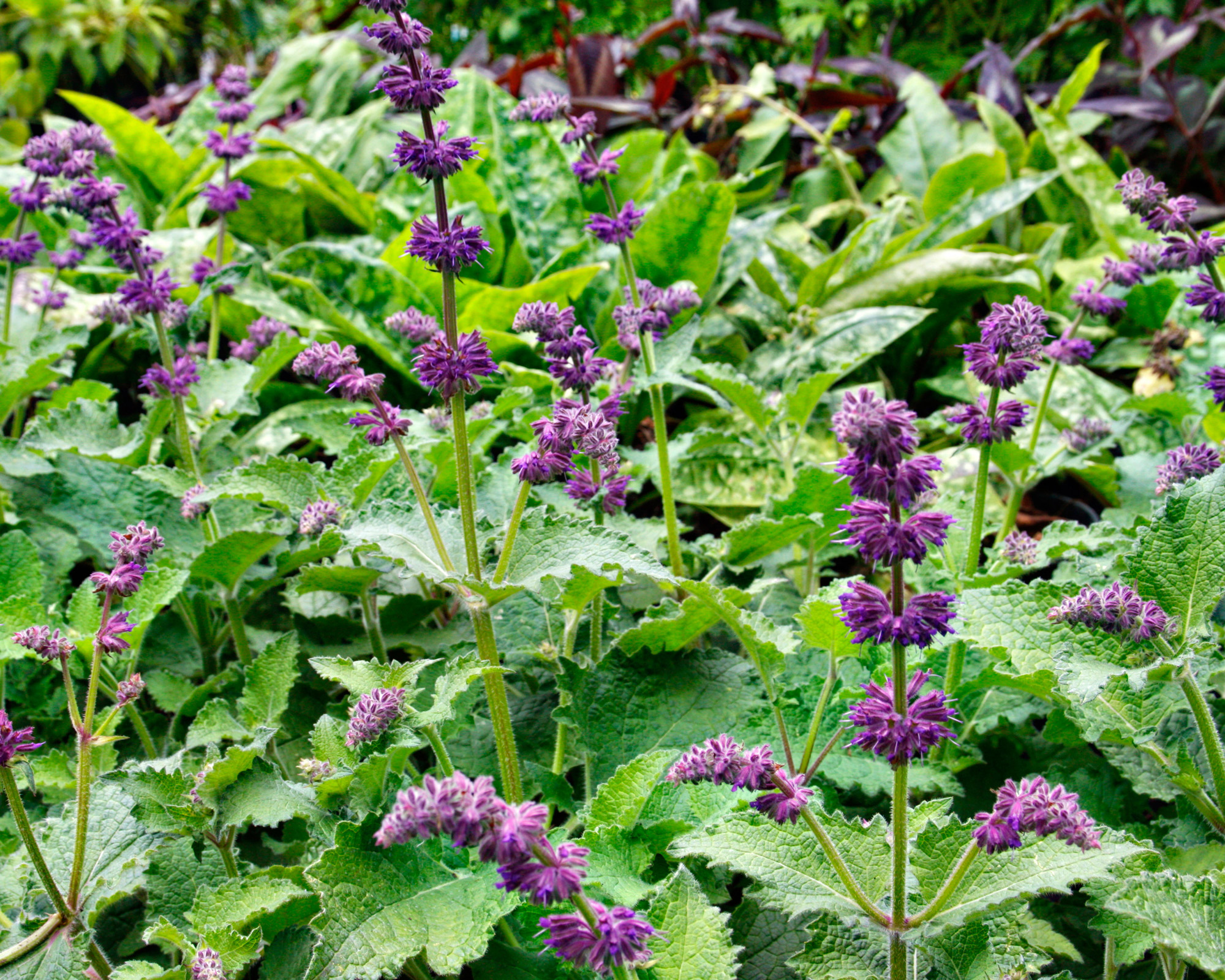
- Height: 28-39in (70-100cm)
- Best for: dramatic blooms
Another delightful salvia for nectar production, this is also a fabulously vibrant and unusual salvia. For those looking for the most dramatic landscaping with flowers, this variety is listed as one of the favourite plants of renowned Dutch plantsman and designer Piet Oudolf.
Salvia verticillata ‘Purple Rain’ has soft, hairy leaves in shades of mid-deep green. Furthermore, the upright flower spikes of these types of salvias comprise reddish-purple stems and rounded clusters of rich purple flowers throughout summer.
13. Salvia Love and Wishes
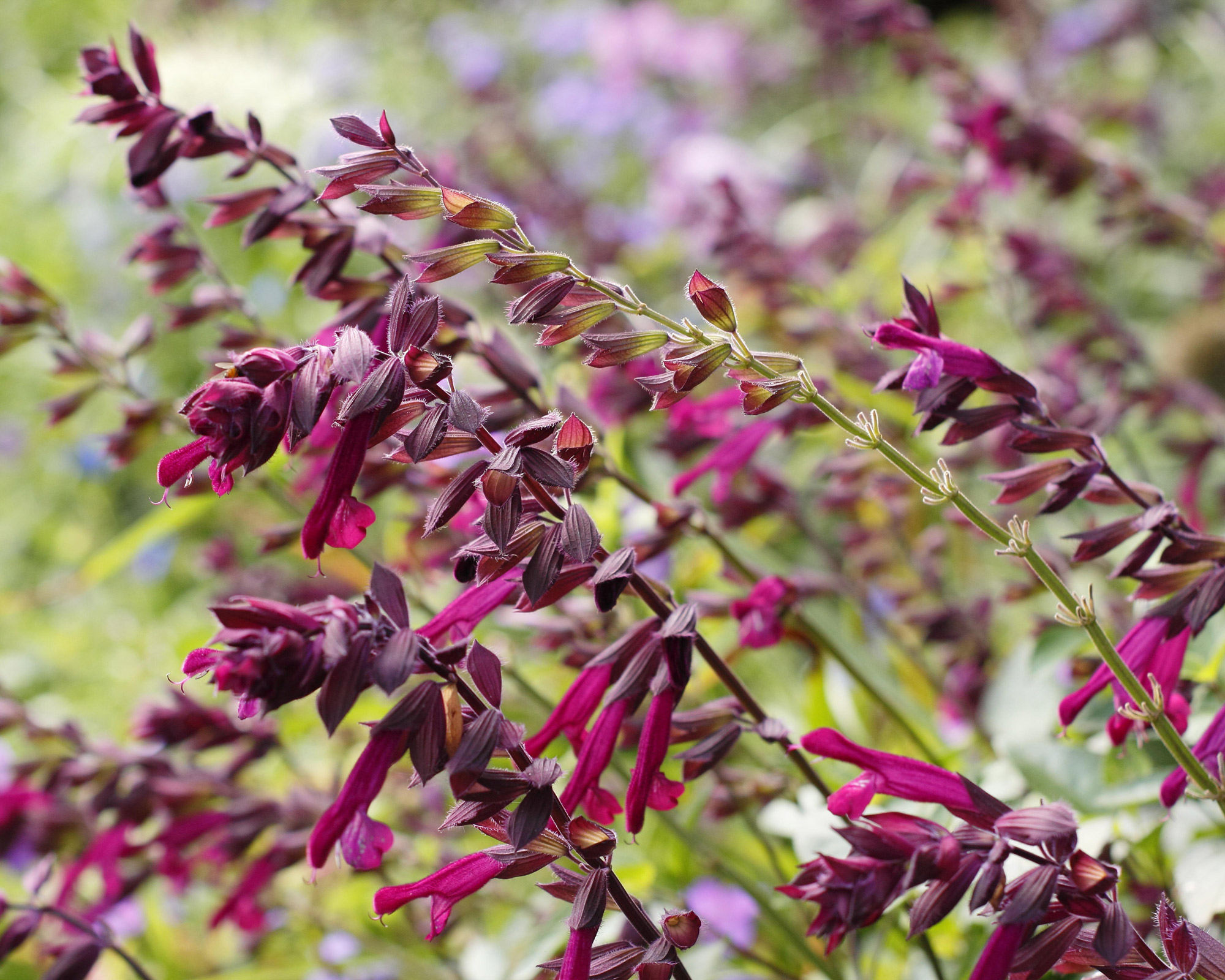
- Height: 28-39in (70-100cm)
- Best for: patios
This pretty perennial, bred in Australia, is part of the Wish Series of salvias. These types of salvias have small, aromatic, mid-dark green leaves and dark stems. Masses of luxuriant red-purple and deep burgundy blooms keep coming, from late spring to mid fall.
If you want the best plants for pollinators, Salvia Love and Wishes is an excellent choice. This nectar-producing salvia variety, with its neat, bushy habit, is also drought-tolerant and perfect for growing in a patio container.
14. Salvia ‘Icterina’ (common sage)
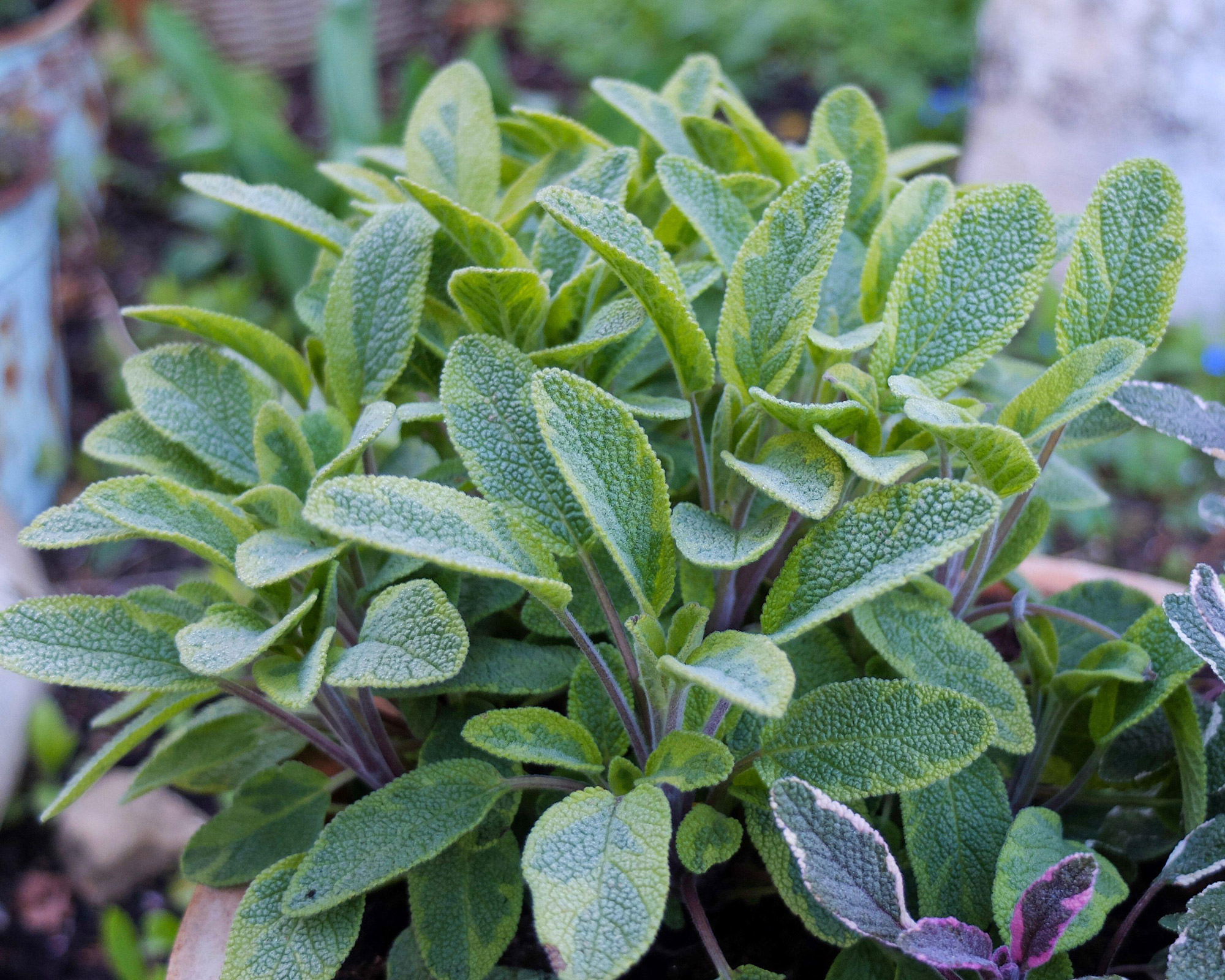
- Height: 20-39in (50-100cm)
- Best for: kitchen gardens
If you are looking for salvia varieties to bring into the kitchen garden, Salvia officinalis ‘Icterina’ (aka common sage) is ideal. The leaves of this dwarf sub-shrub have a peppery taste and can flavour fatty meats as stuffing or in a sauce, and also add flavour with pickles and soft cheeses.
For those with a small garden, these evergreen types of salvias are a great choice. These dwarf sub-shrubs have aromatic, oblong leaves, which are variegated light and dark green. This AGM winner also produces small pale lavender-blue flowers in summer.
15. Salvia lavandulifolia
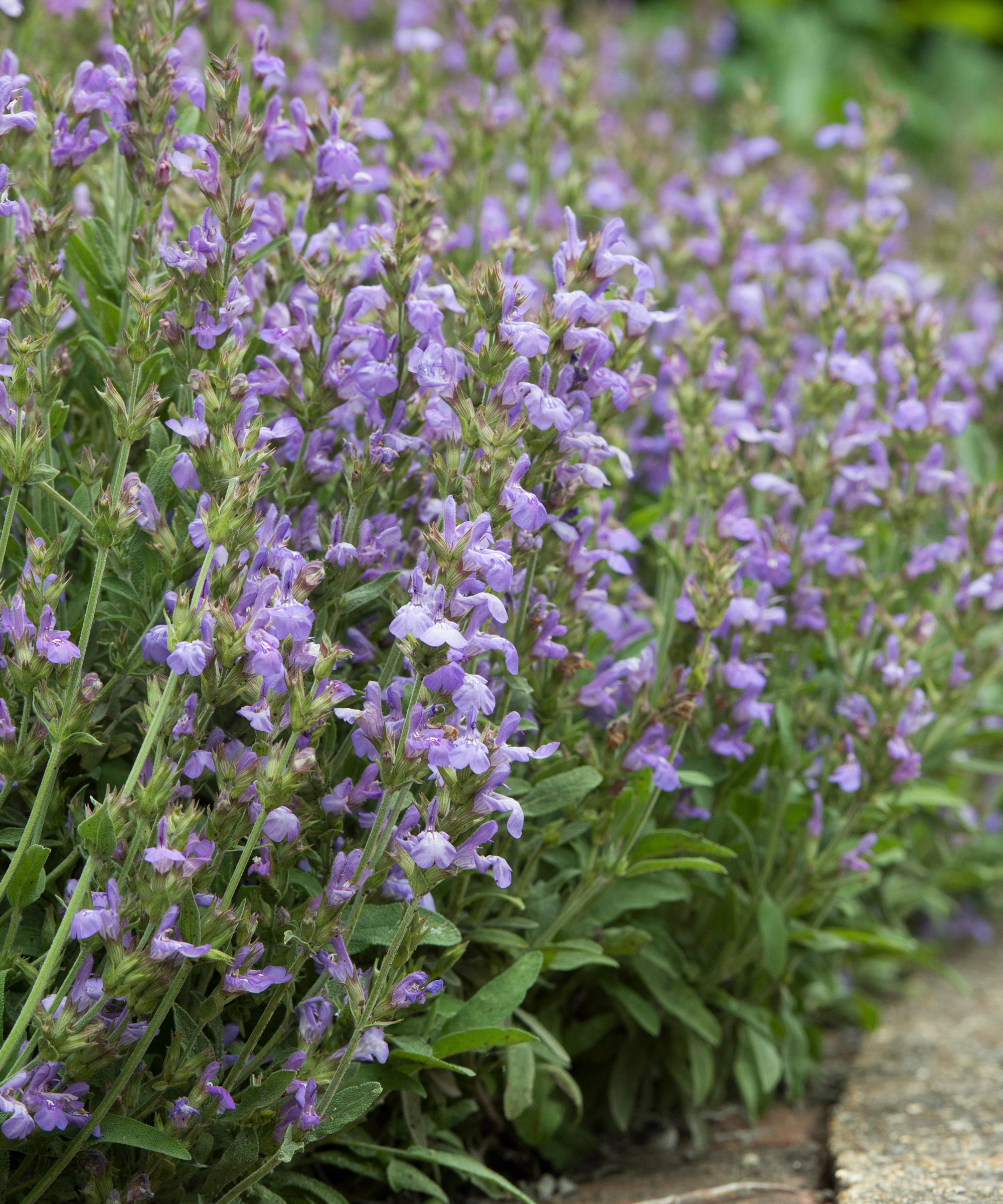
- Height: H: 24-28in (60-70cm)
- Best for: fragrance
With narrow, grey-green leaves that have a wonderful fragrance, the narrow-leaved sage is one of the most charming types of salvias. If you are looking to create a herb garden, this salvia also produces light blue-mauve flowers that are highly attractive to bees.
This is another one of those salvia varieties that is ideal for culinary purposes. With a stronger flavour than common sage, Salvia lavandulifolia is used in stuffings and sauces, and also adds flavour to soft cheese. It is also used in the production of sage oil.
16. Salvia ‘Tangerine’
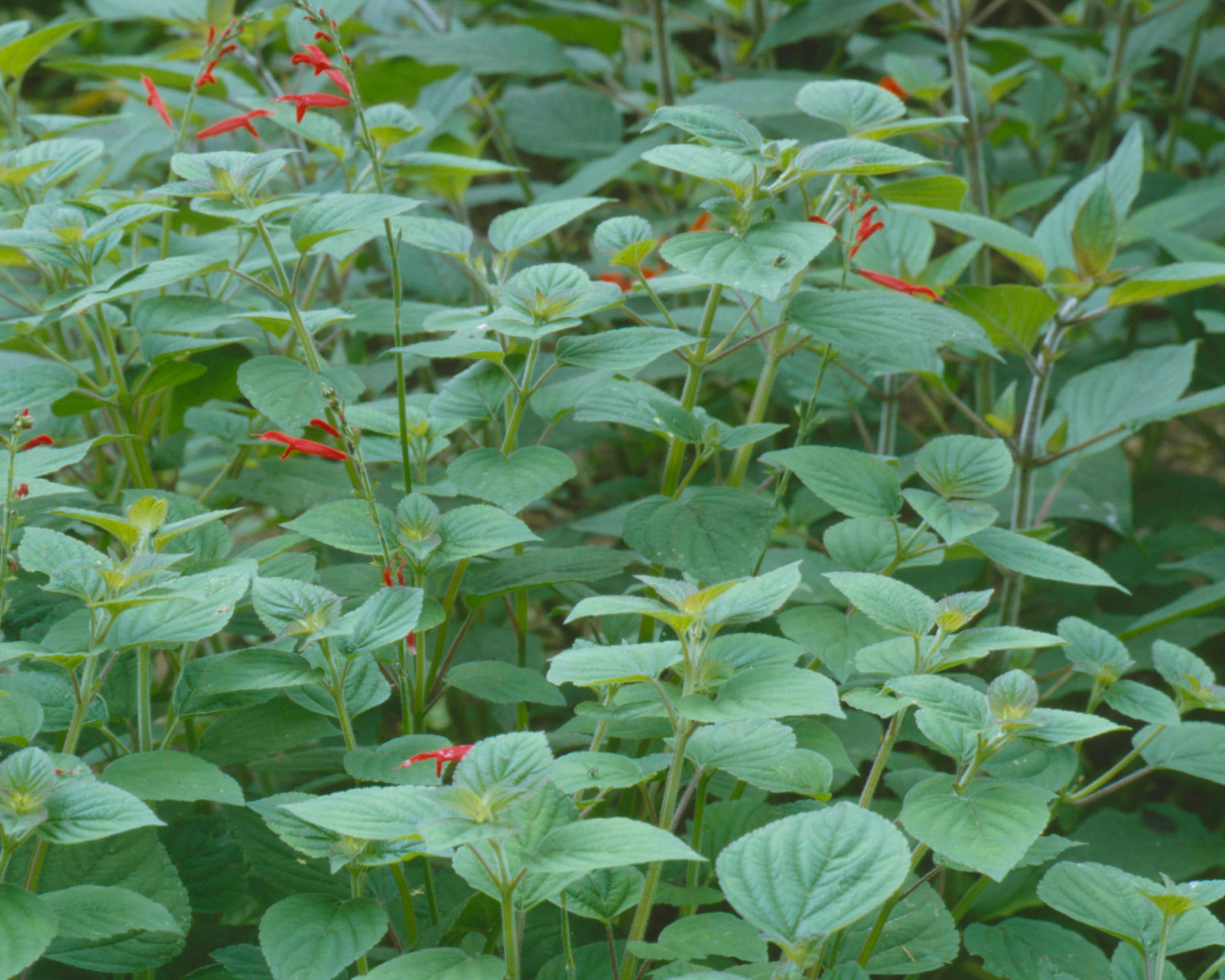
- Height: H: 24in (60cm)
- Best for: fruity smells
Salvia elegans ‘Tangerine’ is one of the most enchanting types of salvias you can grow, with spires of red flowers appearing in summer. The pineapple sage is a delightful bushy perennial, although it is tender, so grow it in a pot and treat it as a houseplant in winter.
As another fine choice for the kitchen garden, its leaves have a strong tangerine-like aroma. And for those who enjoy tropical flourishes, the flowers of this salvia can be added to fruit drinks and cocktails – plus, you can add the blooms and snipped-leaves to salads.
What types of salvias are hardy?
Many types of salvias are capable of withstanding milder weather as well as intense heat. 'Hot Lips', 'Purple Rain' and 'Jemima’s Gem' are particularly hardy. The hardiest salvias are said to include microphylla and patens varieties. However, real hardiness will vary from species to species. Depending on region, perennial and shrubby hybrid salvias can be a little on the tender side. That doesn’t mean you can’t grow such salvias. If your garden is susceptible to frost, it may just mean plants need to be treated as annuals. Still, there are indications that salvias may be adapting.
Last winter, gardeners at RHS Harlow Carr in Yorkshire, England, were surprised that some of their salvias – originally from Mexico, but kept out over a Yorkshire winter – survived a snow covering, as well as several days of temperatures below 32°F (0°C). Not only did the plants stay alive, they even kept their leaves. As a general rule, winter wet often dictates whether a salvia plant will survive. It’s worth checking your soil types and making sure your soil is free-draining to ensure salvia success.
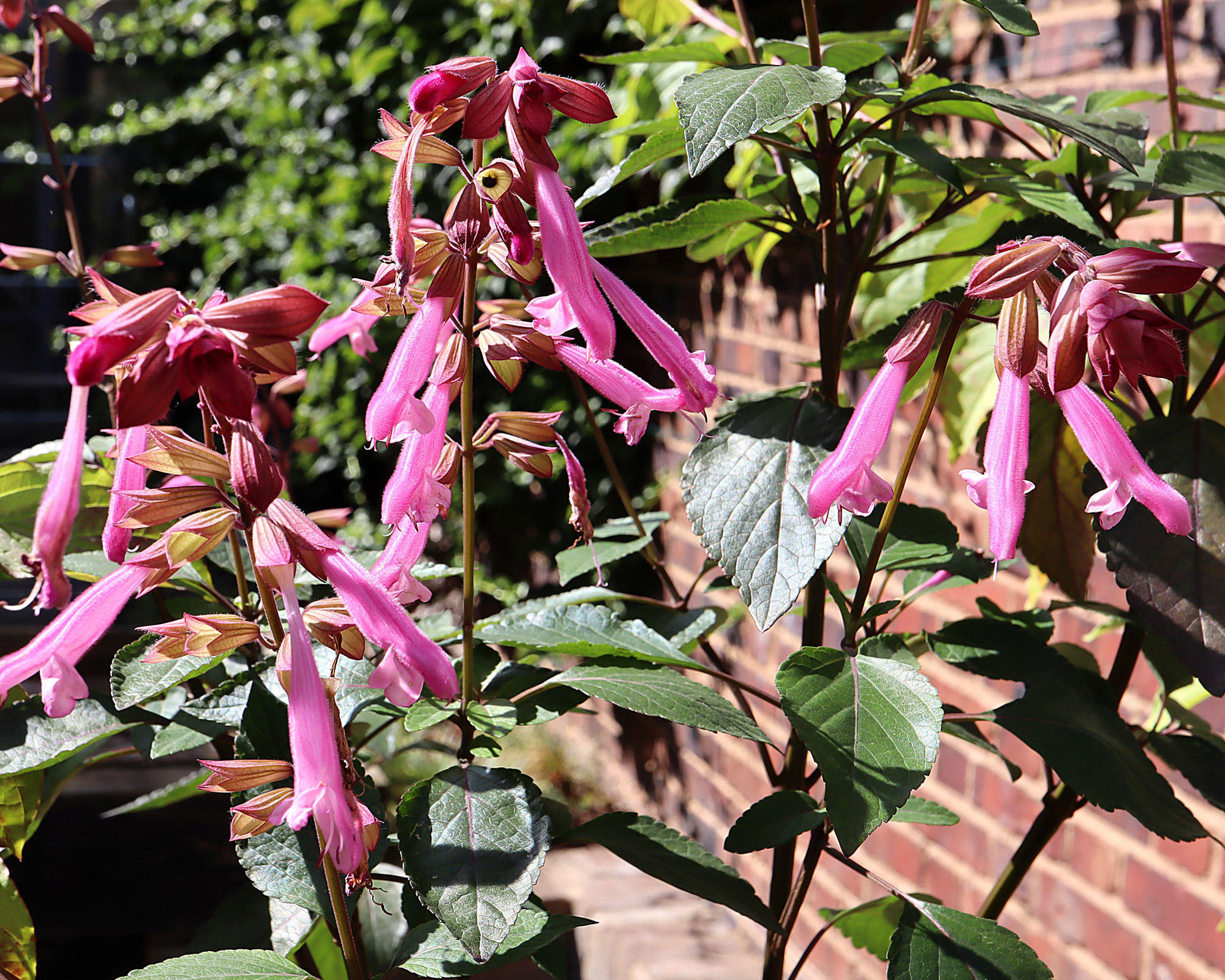
How many types of salvias are there?
There are over 900 species of salvia, as well as a host of hybrids, and this number includes shrubs, annuals and perennials. Gardener Monty Don's favorite salvias, which he grows in his own Jewel Garden, include a wide range of varieties, showcasing just how versatile these plants can be.
As we have already touched on, many tender perennials can be grown as annuals in colder areas. Within the main genus of plants in the Lamiaceae family, different salvia varieties range widely in tone and shape, from the floriferous ornamentals to culinary types grown in kitchen gardens.
Some key phrases you'll hear for different types of salvias include ‘shrub-forming’, ‘herbaceous’ and ‘rosette-forming’. Each requires different maintenance and care, particularly if you need to know how to prune salvias, so make sure you understand which type you have selected:
- Shrub-forming salvia varieties form woody stems, and include Salvia officinalis (edible sage), Salvia greggii and ‘Hot Lips’ in our selection.
- Deciduous herbaceous salvias die back in winter; from our round-up, ‘Amistad’ and Salvia elegans (pineapple sage) are good examples.
- Rosette-forming salvias produce tall flower spikes from rosettes of evergreen leaves; examples include woodland sage (Salvia nemorosa).
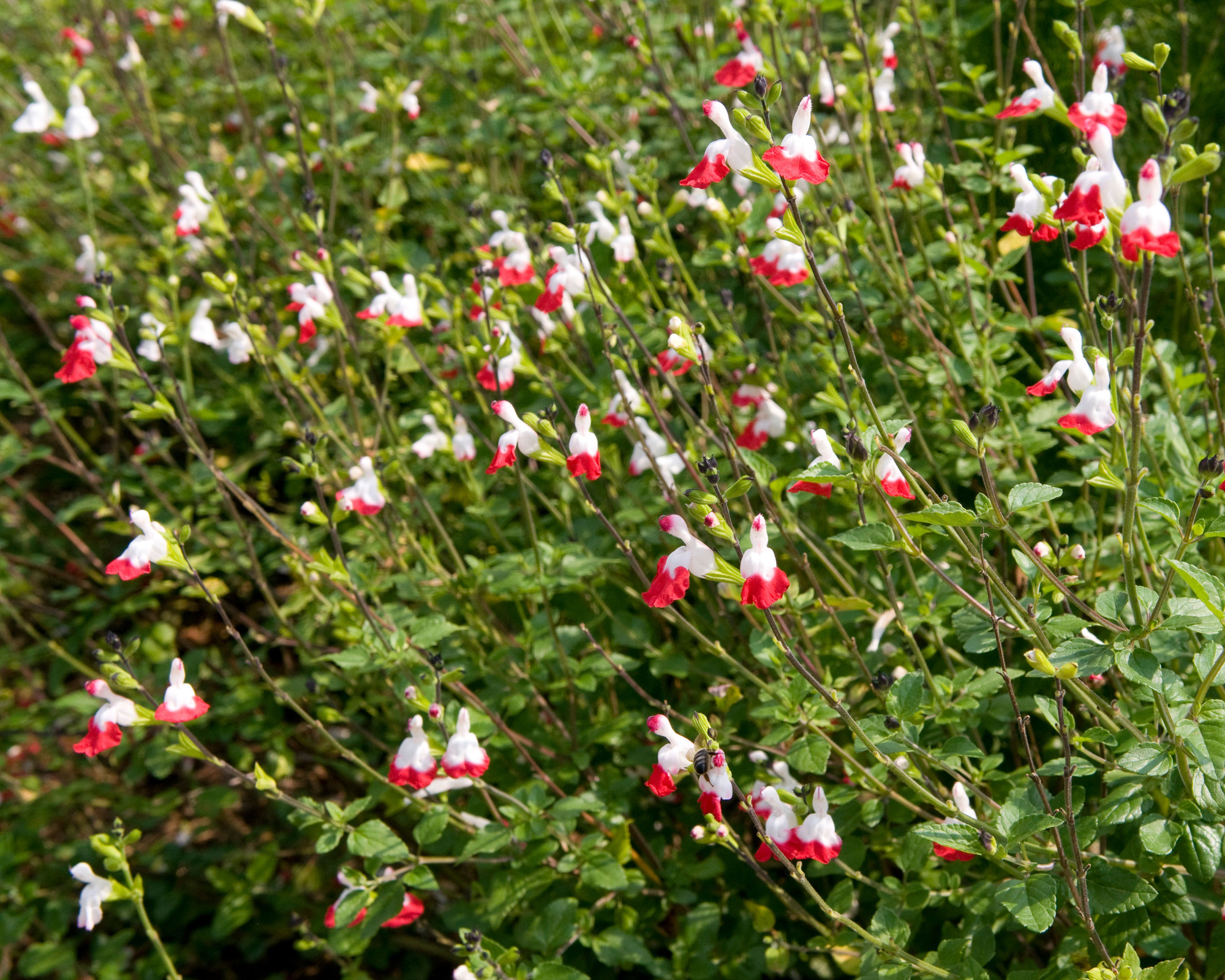
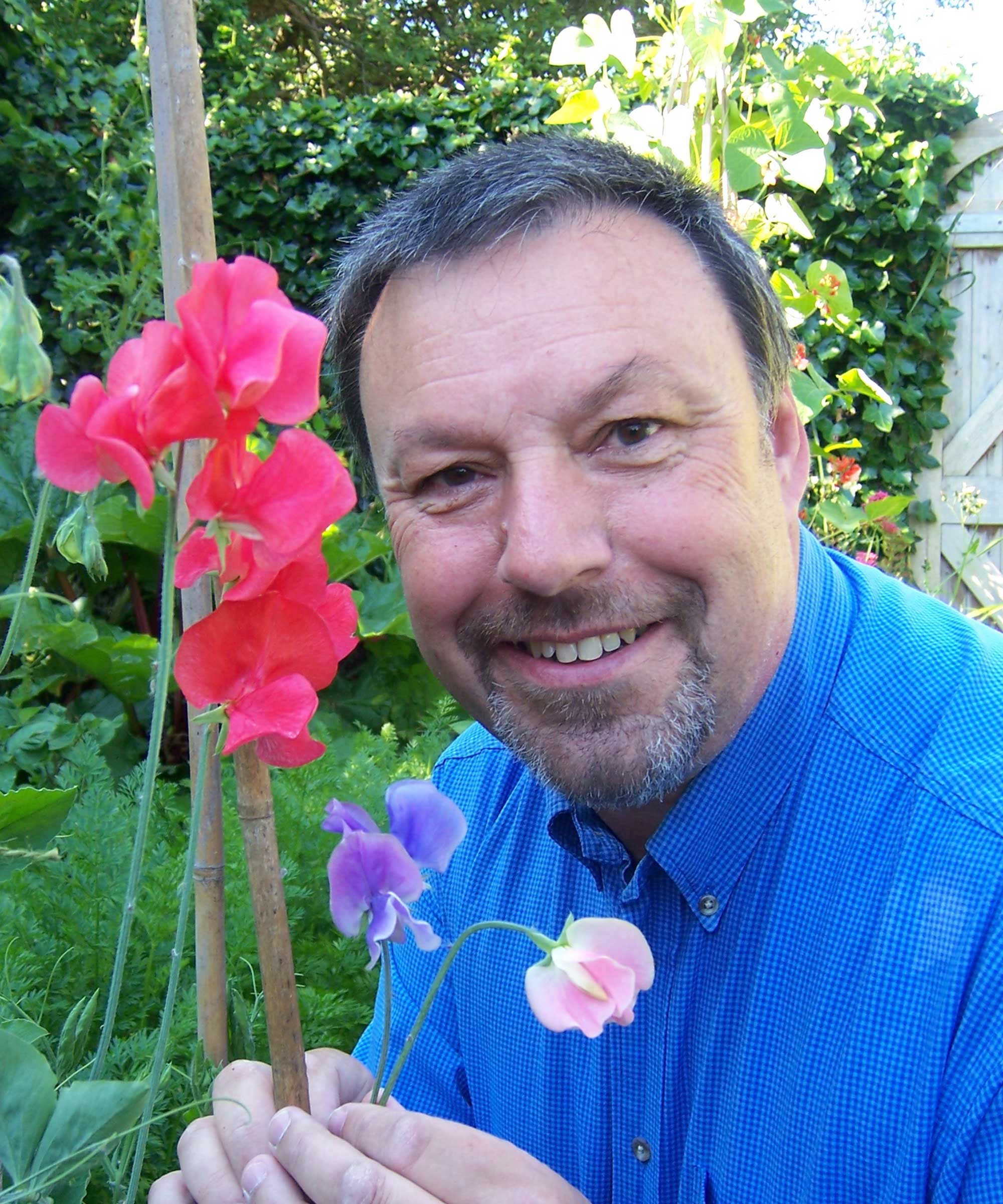
Graham Clarke is an award-winning writer, who was born into gardening – literally: his father was in charge of Regent’s Park in London, and the family lived in the world-famous Queen Mary Rose Garden. Graham studied with the Royal Horticultural Society at Wisley, and after graduating went to work in the garden at Buckingham Palace. In the past 45 years, Graham has written 20 books, and thousands of articles for many of the UK's best-known gardening magazines, newspapers and periodicals. He was editor of Amateur Gardening (the UK’s oldest weekly magazine for amateurs) for 11 years.
